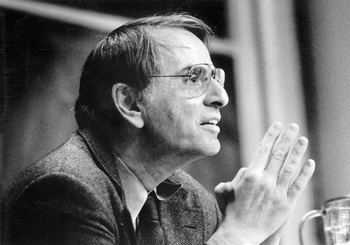COVER STORY SIDEBAR
Faculty legends: Carl Sagan
"Somewhere, something incredible is waiting to be known."
These words from the late Carl Sagan typify his tremendous sense of wonder about nature. For Sagan, science was much more than an exercise of the mind. It satisfied something seemingly visceral: the innate and insatiable curiosity of the human species.

Faculty legends: Carl Sagan. Photo: Division of Rare and Manuscript Collections. See larger image
And when Sagan conveyed that sense of wonder through television, most notably on the PBS series "Cosmos: A Personal Voyage," it made him the most recognizable scientist on the planet.
"Our contemplations of the cosmos stir us; there's tingling in the spine, a catch in the voice, a faint sensation as of a distant memory of falling from a great height," said Sagan in the first episode of "Cosmos." "We know we are approaching the grandest of mysteries."
"Cosmos" won Emmy and Peabody awards and was viewed by more than half a billion people in 60 countries.
Sagan came to Cornell in 1968 and became a full professor in 1971. He was the David Duncan Professor of Astronomy and Space Sciences and director of the Laboratory for Planetary Studies at Cornell at the time of his death at the age of 62.
"Carl was a candle in the dark. He was, quite simply, the best science educator in the world this century," Yervant Terzian, chair of the astronomy department, said in 1996 following Sagan's death. Terzian is now the Tisch Distinguished University Professor of Astronomy.
Sagan published more than 600 scientific papers and popular articles and was author, co-author or editor of more than 20 books, including "The Dragons of Eden," for which he won the Pulitzer Prize in 1978.
His research included such topics as the greenhouse effect on Venus; windblown dust as an explanation for the seasonal changes on Mars; organic aerosols on Saturn's moon Titan; and the catastrophic environmental consequences of nuclear war.
As an adviser to NASA, Sagan played a leading role in expeditions to explore the solar system, and briefed the Apollo astronauts before their flights to the moon. Sagan helped to develop and assemble the first physical messages sent into space: gold-anodized plaques and discs attached to the space probes Pioneer 10 and 11 and, later, the two Voyager space probes.
Steven Squyres '78, Ph.D. '81, is Cornell's Goldwin Smith Professor of Astronomy and worked closely with Sagan as a graduate student. "Carl was a remarkable teacher, whether he was explaining the nature of geologic time to freshmen in Astronomy 102 or deriving equations for grad students in his Physics of the Planets course," Squyres said. "All of us who had the chance to learn from him are better scientists or simply better-informed citizens for the experience."
– Gary E. Frank